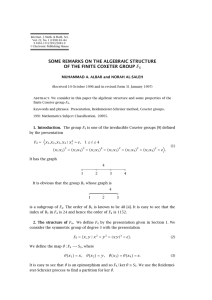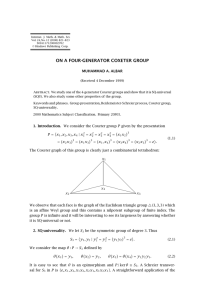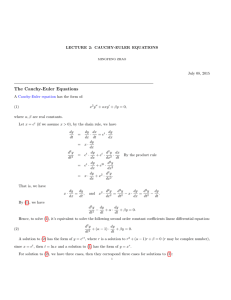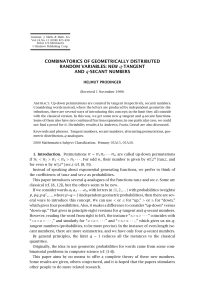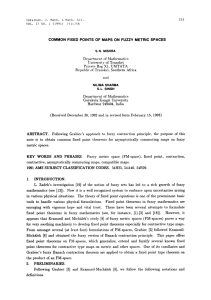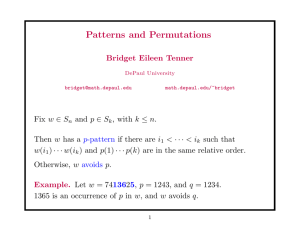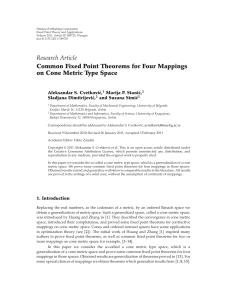Internat. J. Math. & Math. Sci. S0161171200002167 © Hindawi Publishing Corp.
advertisement
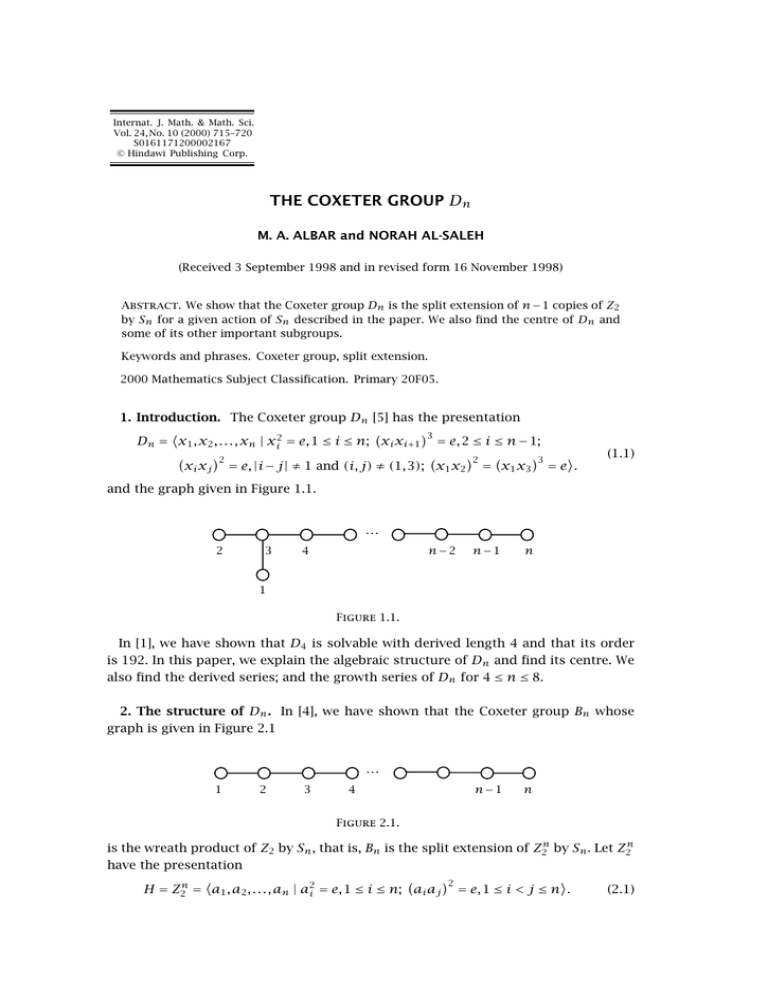
Internat. J. Math. & Math. Sci.
Vol. 24, No. 10 (2000) 715–720
S0161171200002167
© Hindawi Publishing Corp.
THE COXETER GROUP Dn
M. A. ALBAR and NORAH AL-SALEH
(Received 3 September 1998 and in revised form 16 November 1998)
Abstract. We show that the Coxeter group Dn is the split extension of n−1 copies of Z2
by Sn for a given action of Sn described in the paper. We also find the centre of Dn and
some of its other important subgroups.
Keywords and phrases. Coxeter group, split extension.
2000 Mathematics Subject Classification. Primary 20F05.
1. Introduction. The Coxeter group Dn [5] has the presentation
3
Dn = x1 , x2 , . . . , xn | xi2 = e, 1 ≤ i ≤ n; xi xi+1 = e, 2 ≤ i ≤ n − 1;
2
2 3
xi xj = e, |i − j| ≠ 1 and (i, j) ≠ (1, 3); x1 x2 = x1 x3 = e .
(1.1)
and the graph given in Figure 1.1.
...
2
3
4
n−2
n−1
n
1
Figure 1.1.
In [1], we have shown that D4 is solvable with derived length 4 and that its order
is 192. In this paper, we explain the algebraic structure of Dn and find its centre. We
also find the derived series; and the growth series of Dn for 4 ≤ n ≤ 8.
2. The structure of Dn . In [4], we have shown that the Coxeter group Bn whose
graph is given in Figure 2.1
...
1
2
3
4
n−1
n
Figure 2.1.
is the wreath product of Z2 by Sn , that is, Bn is the split extension of Z2n by Sn . Let Z2n
have the presentation
2
(2.1)
H = Z2n = a1 , a2 , . . . , an | a2i = e, 1 ≤ i ≤ n; ai aj = e, 1 ≤ i < j ≤ n .
716
M. A. ALBAR AND N. AL-SALEH
Let K be the even subgroup of H, that is, the subgroup consisting of even words in
H. It is easy to find the following presentation for K:
2
K = b2 , b3 , . . . , bn | bi2 = e, 2 ≤ i ≤ n; bi bj = e, 2 ≤ i < j ≤ n ,
(2.2)
where bi = a1 ai , 2 ≤ i ≤ n. Thus K is Z2n−1 . In the extension Bn Z2n Sn , the action of
Sn on Z2n is a natural one that can be explained as follows. Let Sn have the presentation
3
Sn = x1 , x2 , . . . , xn−1 | xi2 = e, 1 ≤ i ≤ n − 1; xi xi+1 = e, 1 ≤ i ≤ n − 2;
2
xi xj = e, 1 ≤ i < j − 1 ≤ n − 2 ,
(2.3)
where xi is the transposition (i i + 1). The action of Sn on H is given by
a1 , a2 , . . . , ai−1 , ai , ai+1 , . . . , an
xi
= a1 , a2 , . . . , ai−1 , ai+1 , ai , . . . , an .
Using this action we compute the action of Sn on K as follows:
x
x
b2 , b3 , . . . , bn 1 = a1 a2 , a1 a3 , . . . , a1 an 1
= a2 a1 , a2 a3 , . . . , a2 an
= b2−1 , b2−1 b3 , . . . , b2−1 bn ,
x
x
b2 , b3 , . . . , bi , bi+1 , . . . , bn i = a1 a2 , . . . , a1 ai , a1 ai+1 , . . . , a1 an i
= a1 a2 , . . . , a1 ai+1 , a1 ai , . . . , a1 an
= b2 , . . . , bi+1 , bi , . . . , bn , 2 ≤ i ≤ n − 1.
(2.4)
(2.5)
We use this action to construct a split extension E of K = Z2n−1 by Sn . A presentation
for this extension is given by the method in [2], E = generators of K, generators of
Sn | relations of K, relations of Sn , the action of Sn on K.
We change the action of Sn on K to the following relations:
x
x
bj i
= bj ,
b2 1 = b2−1 ,
(2.6)
x
bi 1 = b2−1 bi , 3 ≤ i ≤ n,
x
bi i = bi+1 , 2 ≤ i ≤ n − 1,
xi
= bi , 2 ≤ i ≤ n − 1,
bi+1
(2.7)
2 ≤ j ≤ n, 2 ≤ i ≤ n − 1, j ≠ i, j ≠ i + 1.
(2.8)
(2.9)
(2.10)
We will use Tietze transformations to show that E is isomorphic to Dn . But before that
x x ···xi−1
, 3 ≤ i ≤ n.
we observe the following. The relation (2.8) implies that bi = b2 2 3
Let ui = x2 x3 · · · xi .
Lemma 2.1. The following identities hold in the group Sn−1 :
(i) uk xi = xi+1 uk , if 2 ≤ i ≤ k,
(ii) uk xi = uk−1 , if i = k,
(iii) uk xi = uk+1 , if i = k + 1,
(iv) uk xi = xi uk , if i > k + 1,
(v) uk ui = (x3 x4 · · · xi+1 )uk , if 2 ≤ i < k,
(vi) uk ui = (x3 x4 · · · xi )uk−1 , if i ≥ k.
717
THE COXETER GROUP Dn
Proof. We will make use of the relations of Sn−1 .
(i)
uk xi = x2 x3 · · · xi xi+1 · · · xk xi
= x2 x3 · · · xi xi+1 xi · · · xk
= x2 x3 · · · xi+1 xi xi+1 · · · xk
(2.11)
= xi+1 x2 x3 · · · xi xk = xi+1 uk .
(ii), (iii), and (iv) are clear, while (v) and (vi) are applications of (i) to (iv).
We reduce relation (2.6) to (2.10) as follows. Relation (2.6) easily becomes
x1 b2
2
= e.
(2.12)
Using Lemma 2.1, (2.7) becomes
b2 x1 x2
3
= e.
(2.13)
x x ···x
i−1
, (2.8) becomes redundant. Relation (2.9), using Lemma 2.1, beUsing bi = b2 2 3
comes redundant. Using Lemma 2.1, (2.10) becomes
xi b2
2
= e,
3 ≤ i ≤ n.
(2.14)
2
The relation bi2 = e = (bi bj ) become redundant for i ≥ 3. Let c = x1 b2 . Then (2.12) be3
comes c 2 = e. Relation (2.13) becomes (cx2 ) = e. Relation (2.14) becomes
2
2
2
(cxi ) = e for i ≥ 3. The relation b2 = e becomes (cx1 ) = e. Therefore a presentation
for E is
E = x1 , x2 , . . . , xn−1 , c | xi2 = e, 1 ≤ i ≤ n − 1; c 2 = e;
2
3
xi xj = e, 1 ≤ i < j − 1 ≤ n − 2; xi xi+1 = e, 1 ≤ i ≤ n − 2;
3
2
cx2 = e; cxi = e, 1 ≤ i ≤ n − 1 and i ≠ 2 .
(2.15)
Consequently, we have proved the following theorem.
Theorem 2.2. The group Dn is the split extension of n − 1 copies of Z2 by Sn .
Remark 2.3. Let us describe the relation between the Coxeter groups Bn and Dn .
It is easy to show that Dn is the subgroup of Bn consisting of all elements of even
length in Bn . Thus Dn is a subgroup of Bn of index 2. On the other hand, let Sn be
the symmetric group of degree n generated by yi , 1 ≤ i ≤ n − 1. We consider the map
θ : Dn → Sn defined by θ(x1 ) = y2 , θ(x2 ) = y2 , and θ(xi ) = yi−1 , 3 ≤ i ≤ n. Using
the Reidemeister-Schreier process, it is possible to show that θ −1 (Sn−1 ) Bn−1 . Hence
Bn−1 is a subgroup of Dn of index n. We observe the graph given in Figure 2.2.
The orders of Bn and Dn are |Bn | = 2n n! and |Dn | = 2n−1 n!, respectively. It is also
.
easy to see that Bn Dn
718
M. A. ALBAR AND N. AL-SALEH
Bn
2
Dn
n
Bn−1
2
.
.
.
Dn−1
B4
2
D4
4
B3
Figure 2.2.
3. The derived series of Dn . In [1], we showed that D4 is solvable of derived
length 4. For n > 4 we use the Reidemeister-Shreier process to find the following
presentation for Dn
:
= b2 , b3 , . . . , bn | b22 = b33 = bi2 = e, 4 ≤ i ≤ n;
Dn
3
2
bi bi+1 = e, 2 ≤ i ≤ n − 1; bi bj = e, 2 ≤ i < j − 1 ≤ n − 1 .
(3.1)
The group Dn
/Dn
is trivial. Hence Dn
is a complete group. We thus have the following
theorem.
Theorem 3.1. Dn is solvable of derived length 4 if n = 4. If n > 4, then Dn is not
solvable.
4. The centre of Dn . We use the structure of Dn explained in Section 2 to prove
the following theorem.
Theorem 4.1. The centre of Dn is Z2 if n is even and trivial if n is odd.
Proof. In Section 2, we showed that Dn is the split extension of Z2n−1 by Sn . This
means the existence of an epimorphism θ : Dn → Sn , where ker θ = Z2n−1 . It follows
that θ(Z(Dn )) ⊆ Z(θ(Dn )) = Z(Sn ) = {e}. Hence Z(Dn ) ⊆ ker θ = z2n−1 . We use the
previous notation where Sn = x1 , x2 , . . . , xn−1 and Z2n−1 = b2 , b3 , . . . , bn and the
previous action. We let w ∈ Z(Dn ) ⇒ w ∈ Z2n−1 and w xi = w for 1 ≤ i ≤ n − 1. Also
w = b22 b33 · · · bnn , where i = 0 or 1 since bi2 = e. Using the action of Sn on Z2n−1 ,
we get
i+1
n
b22 b33 · · · bi i bi+1
· · · bn
xi
i+1
n
= b22 b33 · · · bi i bi+1
· · · bn
.
(4.1)
719
THE COXETER GROUP Dn
Letting 2 ≤ i ≤ n − 1, we get
i
i+1
n
n
bi i+1 · · · bn
= b22 b33 · · · bi i bi+1
· · · bn
,
b22 b33 · · · bi+1
(4.2)
i
i+1
and so bi+1
bi i+1 = bi i bi+1
. This implies i = i+1 and so 2 = 3 = · · · = n . Hence
0
w = b2 b3 · · · bn or w = b20 b30 · · · bn
= e. Now, we consider the action of x1 on w in the
following two cases:
x
(a) If n is even, we get (b2 b3 · · · bn ) 1 = b2n−2 b2 b3 · · · bn = b2 b3 · · · bn since b22 = e.
2
Hence b2 b3 · · · bn is in the centre of Dn . Since (b2 b3 · · · bn ) = e, we get Z(Dn ) = Z2 .
x1
(b) If n is odd, (b2 b3 · · · bn ) = b3 b4 · · · bn and b2 b3 · · · bn does not commute with
0
= e and Z(Dn ) = {e}.
x1 . Thus w is b20 b30 · · · bn
5. The growth series. The growth series, in the sense of Milnor and Gromov, of Dn
for 4 ≤ n ≤ 8 were computed as follows [3]:
2 4
1 − t + t2 1 + t + t2 ,
γ D4 = (1 + t) 1 + t 2
(5.1)
2 4
1 + t4 1 − t + t2 1 + t + t2 1 + t + t2 + t3 + t4 ,
γ D5 = (1 + t) 1 + t 2
(5.2)
2 2 2
6
1 + t4 1 − t + t2
1 + t + t2
γ D6 = (1 + t) 1 + t 2
× 1 − t + t2 − t3 + t4 1 + t + t2 + t3 + t4 ,
(5.3)
3 2 2 6
γ D7 = (1 + t) 1 + t 2
1 + t4 1 − t + t2
1 + t + t2
1 − t2 + t4
× 1 − t + t2 − t3 + t4 1 + t + t2 + t3 + t4 1 + t + t2 + t3 + t4 + t5 + t6 ,
(5.4)
4 2 2 2
8
γ D8 = (1 + t) 1 + t 2
1 + t4
1 − t + t2
1 + t + t2
× 1 − t2 + t4 1 − t + t2 − t3 + t4 1 + t + t2 + t3 + t4
× 1 − t + t2 − t3 + t4 − t5 + t6 1 + t + t2 + t3 + t4 + t5 + t6 .
(5.5)
We make two observations about these growth polynomials. First, each growth series
is a product of cyclotomic polynomials. Second, the value of the series at 1 is the order
of the corresponding group and the degree of the growth series equals the length of
the element of maximal length.
We have not yet succeeded in finding the growth series of Dn for general n.
Acknowledgement. The first author (MAA) acknowledges KFUPM’s support.
References
[1]
[2]
[3]
[4]
M. A. Albar, Analogues of the braid group and their corresponding Coxeter groups, Comm.
Algebra 12 (1984), no. 23-24, 2977–2984. MR 86g:20041. Zbl 591.20046.
, On presentation of group extensions, Comm. Algebra 12 (1984), no. 23-24, 2967–
2975. MR 86g:20040. Zbl 551.20017.
M. A. Albar, M. A. Al-Hamed, and N. A. Al-Saleh, The growth of Coxeter groups, Math. Japon.
47 (1998), no. 3, 417–428. MR 99f:20066. Zbl 912.20032.
M. A. Albar and N. A. Al-Saleh, On the affine Weyl group of type Bn , Math. Japon. 35 (1990),
no. 4, 599–602. MR 91d:20030. Zbl 790.20048.
720
[5]
M. A. ALBAR AND N. AL-SALEH
H. S. M. Coxeter and W. O. J. Moser, Generators and Relations for Discrete Groups, 4th
ed., Ergebnisse der Mathematik und ihrer Grenzgebiete [Results in Mathematics and
Related Areas], vol. 14, Springer-Verlag, Berlin, 1980. MR 81a:20001. Zbl 422.20001.
M. A. Albar: Department of Mathematical Sciences, King Fahd University of
Petroleum and Minerals, Dhahran, Saudi Arabia
Norah Al-Saleh: Department of Mathematics, College of Girls, Dammam, Saudi
Arabia
